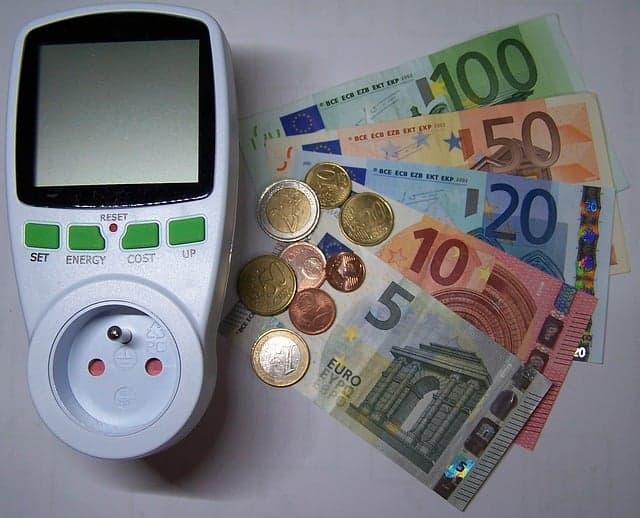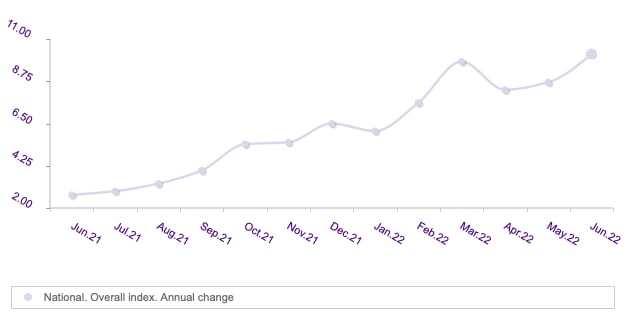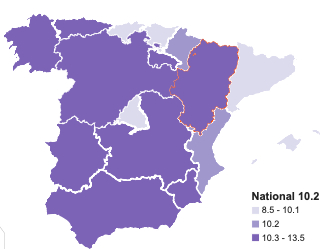Rate of inflation in Spain reaches highest level in 37 years

Spain's rate of inflation has jumped to 10.2 percent, the highest level since 1985, according to data from Spain's National Institute of Statistics (INE).
The Spanish Consumer Price Index (CPI) - the instrument used to measure inflation - rose by 10.2 percent year-on-year in June, the first time it has broken the 10 percent threshold since April 1985, according to data from the National Statistics Institute (INE).
The CPI increased again from 8.7 percent the previous month, a 1.5 percent jump, and the June data represents an increase of 0.4 percent on the peak month of March, which was 9.8 percent.
Core inflation (which does not include unprocessed food or energy product prices in its calculations) increased six tenths in June, to 5.5 percent, itself the highest value since August 1993.
What is the CPI?
According to the INE's website, the CPI is a "statistical measure of the evolution of the prices of goods and services consumed by the population that reside in family dwellings in Spain."
The percentage change in CPI is a way of measuring inflation.

An INE graph showing monthly changes in the CPI in 2021/2022. Photo: INE
Food and energy
The cause of the CPI's sharp rise in June, the INE says, was largely down to price increases in fuel, electricity, and food.
Food products registered a year-on-year increase of 12.9 percent in June, a rate almost two points higher than the May numbers and the highest since January 1994. Of the increasing food prices, the price of fruits, vegetables, meat, bread, cereals, and cheese were particularly pronounced.
The prices of oils and fats have grown by 37 percent. Eggs are 23.9 percent more expensive, and several other staple foodstuffs have increased by double-digits: notably milk (20.4 percent) and fresh fruits (19.3 percent).
Equally, rises in fuel prices led to the year-on-year rate in transport rising by an eye watering 19.2 percent, more than four points above that recorded in May, while the knock-on effects of spiking food prices have caused the year-on-year rate of hotels, bars, and restaurants in June to rise to 7.2 percent, 0.9 percent more than in May.
In the last year alone, heating, lighting and water prices have increased by a staggering 35 percent.
READ ALSO: Spain to slap windfall taxes on banks, energy firms
READ ALSO: Spain to cut electricity tax by half to ease inflation pain
Regional breakdown

An INE graphic showing the regional CPI rises across mainland Spain. Photo: INE
The rise in prices however, isn't spread evenly across Spain.
Castilla-La Mancha recorded the highest inflation in June with 12.7 percent, followed by Castilla y León with 11.6 percent and Galicia with 11.1 percent.
Prices continued to rise but stayed below 9 percent in the Canary Islands (8.5 percent), and in Ceuta (9.3 percent) and Madrid (9.5 percent) prices continued to rise by stayed below the double-digit threshold.
Despite these slight regional variations, Spaniards across the country are facing the financial pinch caused by a double-pronged economic malaise of rising fuel bills as a byproduct of Russia's invasion of Ukraine, and restarting the economy after two years of shut-down after the COVID-19 pandemic.
Comments
See Also
The Spanish Consumer Price Index (CPI) - the instrument used to measure inflation - rose by 10.2 percent year-on-year in June, the first time it has broken the 10 percent threshold since April 1985, according to data from the National Statistics Institute (INE).
The CPI increased again from 8.7 percent the previous month, a 1.5 percent jump, and the June data represents an increase of 0.4 percent on the peak month of March, which was 9.8 percent.
Core inflation (which does not include unprocessed food or energy product prices in its calculations) increased six tenths in June, to 5.5 percent, itself the highest value since August 1993.
What is the CPI?
According to the INE's website, the CPI is a "statistical measure of the evolution of the prices of goods and services consumed by the population that reside in family dwellings in Spain."
The percentage change in CPI is a way of measuring inflation.

The cause of the CPI's sharp rise in June, the INE says, was largely down to price increases in fuel, electricity, and food.
Food products registered a year-on-year increase of 12.9 percent in June, a rate almost two points higher than the May numbers and the highest since January 1994. Of the increasing food prices, the price of fruits, vegetables, meat, bread, cereals, and cheese were particularly pronounced.
The prices of oils and fats have grown by 37 percent. Eggs are 23.9 percent more expensive, and several other staple foodstuffs have increased by double-digits: notably milk (20.4 percent) and fresh fruits (19.3 percent).
Equally, rises in fuel prices led to the year-on-year rate in transport rising by an eye watering 19.2 percent, more than four points above that recorded in May, while the knock-on effects of spiking food prices have caused the year-on-year rate of hotels, bars, and restaurants in June to rise to 7.2 percent, 0.9 percent more than in May.
In the last year alone, heating, lighting and water prices have increased by a staggering 35 percent.
READ ALSO: Spain to slap windfall taxes on banks, energy firms
READ ALSO: Spain to cut electricity tax by half to ease inflation pain
Regional breakdown

The rise in prices however, isn't spread evenly across Spain.
Castilla-La Mancha recorded the highest inflation in June with 12.7 percent, followed by Castilla y León with 11.6 percent and Galicia with 11.1 percent.
Prices continued to rise but stayed below 9 percent in the Canary Islands (8.5 percent), and in Ceuta (9.3 percent) and Madrid (9.5 percent) prices continued to rise by stayed below the double-digit threshold.
Despite these slight regional variations, Spaniards across the country are facing the financial pinch caused by a double-pronged economic malaise of rising fuel bills as a byproduct of Russia's invasion of Ukraine, and restarting the economy after two years of shut-down after the COVID-19 pandemic.
Join the conversation in our comments section below. Share your own views and experience and if you have a question or suggestion for our journalists then email us at [email protected].
Please keep comments civil, constructive and on topic – and make sure to read our terms of use before getting involved.
Please log in here to leave a comment.